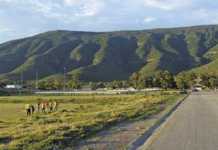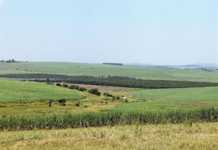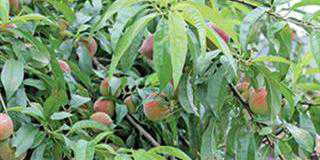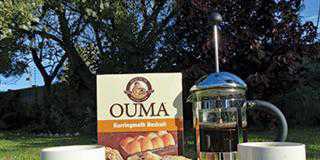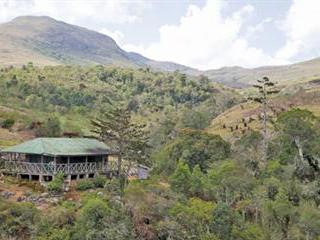
"There!” whispers my guide Fael. We’re on Mount Mulanje in Malawi, and 20m away, just beyond the outline of a rock, I see the head of a panda. It’s facing away from us, but there’s no mistaking the black ears and the grubby white, teddy bear curve of its head.
Fael clears his throat and the bear turns, becoming a man wearing a panda hat. He drops out of sight and, moments later, an older man takes off across the river, followed by an athletic, panga-carrying youth. Panda Hat, meanwhile, beats it along the river bank.
Fael shouts out reassurances – and the men return warily to their workplace, a flat bit of riverside littered with roughly hewn planks of cedar. We make a deal, a few thousand Malawian kwacha (there are about 20MWK to the rand) for a conversation, and sit down among the woodchips.
This is why I’m here – to learn more about the destruction of Malawi’s national tree, the Mulanje cedar (Widdringtonia whytei), which is being decimated by illegal woodcutters like the three we’ve disturbed. In fact, it may soon qualify for the International Union for Conservation of Nature’s red list for critically endangered species.
Risk and rewards
Through Fael, the woodcutters tell their story, and the risks they face. Getting caught, they say, can earn them four years in Zomba prison or a 25 000MWK (about R1 200) fine– a lot of money if you work on the tea estates earning less than R1 a day filling a 40kg bag with tea leaves.
Cedar cutters, by contrast, get about 1 500MWK (R70) for every 1,8m-long, 25mm-thick plank they sell. The men say they cut an average of 60 planks from a tree, and can process three trees a month if they work hard. They only work an average of three days a week because the climb is so arduous – it took us five hours, but takes them only two. They leave at 4am and are chopping by 6am, when the sounds of their labour are unlikely to be heard.
The men claim they can make up to R4 000 a month – a fortune, given the state of the local economy. Inevitably, these rewards have given rise to territorialism. One of the woodcutters writes “musa male” (be careful) on each plank with charred bark, as a warning to other gangs. Mama Valley, this narrow, forested ravine where we are sitting, is theirs. The three have fought to protect it before and will again.
As with the baobab in its native lowveld, it’s possible to get a mistaken sense of the Mulanje cedar’s numbers. It towers over its competitors, its lichen-draped branches stretching across the forest canopy. But the threats to its existence are very real.
“You must remember there are five villages at the foot of just this path,” says Fael. “In every village there will be at least 10 men cutting cedar.”
Corruption
Fael’s figures – and fears – echoed those of David Nangoma, an ecologist with the Mount Mulanje Conservation Trust (MMCT), whom I had spoken to earlier. According to a World Bank funding proposal, in 2000 there were 105 000 people living in 100 villages within 5km of the reserve boundary. Given the value of the wood and the prevailing poverty, the department of forestry awards annual licences to about 40 cedar sawyers.
But the licence terms are vague, explains David. “One must prove only that one has the financial means to pay one’s workers, and afterwards to remove one’s equipment from the mountain. The licence is only supposed to apply to dead cedar, but this is an empty clause that merely leads to the ring-barking of trees.”
The relationship between the MMCT and the forestry department has become uneasy, especially since conservationists began uncovering cases of corruption. One MMCT file indicts a former government minister who secured a concession to establish an “eco lodge” on the mountain, which the MMCT suspects is a front for cedar logging. The file, complete with photographs of trucks of cedar planks, has been gathering dust at the forestry department.
Prized for ages
It is not merely in the last few years that the cedar has been under threat. Prized by British botanists as “equal to the finest yellow pine”, it has suffered exploitation for over a century. But its vulnerability has long been recognised too. In 1920, the chief forest officer ordered the creation of firebreaks around the clumps of cedar forest, as fires from the increasingly populated plains were considered a great threat to the tree’s existence.
This went on for 90 years, along with periodic replanting and bans on logging – yet cedar numbers continued to decline. What went wrong? “Do you want the short answer or the long one?” asks David. The short answer involves politics. “As I speak to you now, two years before the next election, the forestry department is asking us to open the mountain for a Mulanje cedar cutting season,” says David.
The government doesn’t know how much stock is available, but it does know this will bring in votes.” This is despite the fact that, in 2007, the last year in which the mountain was opened to loggers, chaos reigned, with the result “that you’ll hardly find a single mature cedar between Chambe and Tuchila today”, claims David.
The long answer implicates the colonials as well. The area was logged intensively in the past, especially in the 1950s when the Nyasaland Timber and Trading Company signed a contract with the government for thousands of cubic feet of Mulanje cedar to the public works department, and erected a mechanised pulley system to meet its targets.
Then there’s the simple fact that the species is poorly understood. “We don’t know enough about the tree’s silviculture,” admits David. “We raise thousands of seedlings every year, of which very few reach this height,” he says, standing and raising his arms.
Ideal wood
On the way to meet the woodcutters, I saw why the Mulanje cedar is so highly prized. Climbing up a steep route that follows the Ruo River, we came across a mountain club hut. It’s made entirely of cedar planks, and is in impeccable condition after more than 50 years. With its fine grain and high resin content, it takes up to 100 years to rot, and it gives off the sweet smell of cypress, even after decades.
Noah’s Ark
Despite so many challenges, the MMCT has redoubled its efforts to save the tree. Together with long term-partner, the Royal Botanic Gardens at Kew in the UK, it’s seeking funding for research into the conservation, restoration and sustainable use of the Mulanje cedar.
A comprehensive management plan may indeed reverse the decline of Malawi’s national tree. But as a sign of just how late this initiative comes, one of MMCT’s proposals is that collections of Mulanje seed be deposited in Kew’s Millenium Seed Bank Project, known informally (and portentously) as the Noah’s Ark of seeds.
Contact the Mulanje Mountain Conservation Trust on 00265 1 466282/179, or email [email protected]. Website: www.mountmulanje.org.mw.


